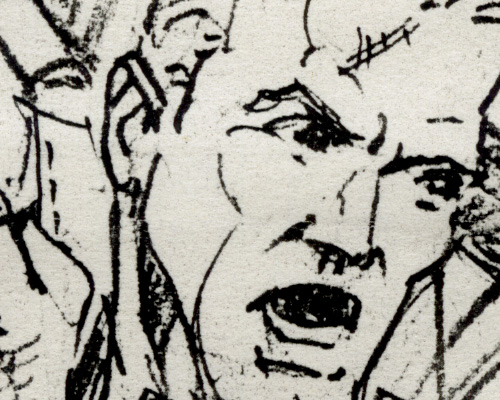Around 2013 and 2014, IDW Publishing reprinted the original Marvel G.I. Joe comics in handsome, oversized hardcovers, a series called The Complete Collection. A limited edition run of these, called “Red Label” (available through your local comic retailer), “Blue Label,” and “Black Label” (available only from a special IDW website) included metaphorical bells and whistles. Only released for the first three volumes of The Complete, these “Label” versions were extremely limited, like quantities of 175 or 25 copies. They featured canvas covers, hand-assembled slipcases, and signature pages signed by the likes of Larry Hama, Herb Trimpe, and Russ Heath. Here are the Red Label editions:
Continue readingCategory Archives: Comic Books
Larry Hama IDW Limited splash page sketch
Filed under Back issues, Comic Books, G.I. Joe Behind the Scenes
Andy Mushynsky ink art – G.I. Joe #28
Filed under Back issues, Comic Books, G.I. Joe Behind the Scenes
Marie Severin pencil art – G.I. Joe #28
Filed under Back issues, Comic Books, G.I. Joe Behind the Scenes
Remembering David Anthony Kraft / interview Part 2 of 3
Filed under Animation, Comic Books, G.I. Joe Behind the Scenes, Interviews
Remembering David Anthony Kraft / interview Part 1 of 3
Filed under Animation, Comic Books, G.I. Joe Behind the Scenes, Interviews
G.I. Joe #35 by Mark Bright

In the numbered 30s, the monthly G.I. Joe comic was a scheduling challenge. The series was about to get a new regular artist, certain issues needed to advertise key toys based on the scheduling of particular TV commercials that hyped the comic, and of course, every issue needed to be approved by folks at Hasbro. Issues #35 and #36 had six artists between them, one of whom was Mark D. Bright.
Filed under Back issues, Comic Books, G.I. Joe Behind the Scenes
Remembering Russ Heath
Filed under Animation, Comic Books, G.I. Joe Behind the Scenes
Podcast – Department of Nerdly Affairs
Rob Paterson and Don Chisholm take a biweekly deep dive on their podcast, Department of Nerdly Affairs. Their topics range from Taiwanese comics to Chinese webnovels to hero pulps to indie RPGs. Recently I guested, and we three talked about G.I. Joe history, toys, comics, and animation. Thanks, gents! Listen here.
Filed under Animation, Comic Books, G.I. Joe Behind the Scenes, Press, Toys and Toy Art









